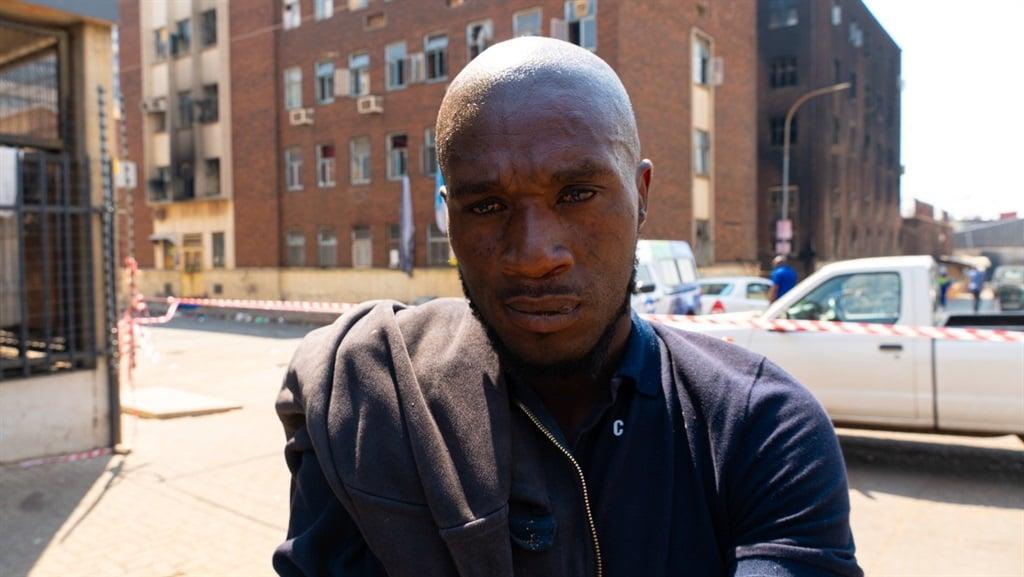Africa-Press – South-Africa. The Usindiso building stood five floors high, but inside, a hamlet of shack-like structures was haphazardly built on every floor, in passages, on stairways and even in the basement.
This impenetrable maze weighed down firefighting efforts to rescue as many people as possible from the horrific inferno that killed almost 80 people in what is now considered the country’s deadliest fire.
Johannesburg Emergency Management Services spokesperson Robert Mulaudzi said an informal settlement inside the building obstructed the firefighters’ path.
“It looked like an informal settlement built inside the building, so we had to start by finding a way for the firefighters to safely access the building without risking their lives,” he said hours after the fire was contained.
Echoing Mulaudzi’s sentiment, firefighters and paramedics, who spoke to News24 on condition of anonymity, said the many shack-like structures inside the building made the blaze more explosive, and the lack of a clear path hindered their rescue efforts.
Those living in the building, which was once a haven for abused women, were a mix of poor South Africans as well as migrants, mostly undocumented, from across Africa.
News24 can now paint a picture of what it looked like inside 80 Albert Street in the Johannesburg CBD, which was taken over by criminal gangs, based on the accounts of four residents who called it home.
Simphiwe Zondo from Vryheid in KwaZulu-Natal said she lived in the building with her three children for almost two years.
She was forced to move out of her flat and into Usindiso after the company where she was employed as a domestic worker shut down during the Covid-19 lockdown.
“It was tough initially, but I was happy we had a [roof] over our heads. Although the conditions were not good, I just made sure that we kept our space clean, and I continue to be a good parent and always remind my children of the good values in life,” she said.
The 40-year-old said stairways and parts of the passages on every floor had been converted into dwellings.
“The shacks were built with boards and plastic covers – and they were everywhere.”
She explained that most rooms would be divided with boards and turned into two or four shacks, while those with more money didn’t separate their rooms.
“So, in most cases, one room would accommodate at least six to eight people, depending on how big the family is,” said Zondo.
She said shacks were built so tightly next to one another that she could barely walk through the small pathways while holding plastic bags in both hands.
A distraught Yandisa Mnqandi, who lost his 15-year-old stepdaughter in the fire, also said walking inside the building was difficult.
Phakama Tshikila, 52, from Bizana in the Eastern Cape, lived on the third floor on the west wing of the building with her 21-year-old son.
She said her one room tripled up as a bedroom, kitchen, and bathroom – and she rented it for R1 110.
“We had done our best to make … it comfortable. We had a double bed, a two-seater couch, a table where we cooked and placed our stove on,” Tshikila said.
“When we had to relieve ourselves, we had to go outside. There were mobile toilets there. I’m not sure who placed them, but they were there, and that’s what we used, although they were not clean because they were not collected or cleaned regularly.”
Nomsa Khumalo, who lived on the first floor, told News24 she shared a single room with four other women, who contributed R350 to make up the monthly R1 400 rent. They used cardboard to split the room into four compartments.
She said she hardly used the communal bathroom on their floor, because it was unsanitary.
“The toilets are blocked, and there’s a bad smell coming from there. Bathtubs are dirty because some people would bath and not clean them afterwards… It used to be white, but now it’s brown. There are showers, too, but they are also not working because there is no water in the building,” she said.
Khumalo said most residents used the street fire hydrants to get water, which they would then carry to their rooms for drinking, cooking and bathing.
“Every day after work, I would get water with a 20-litre bucket. When I’m too tired, I would ask one of the boys in the building to go get it for me, and I would pay them R10,” she said.
Sphamandla Qwede, from Libode in the Eastern Cape, lived in a brick-and-mortar one-room on the roof of the building.
Although he had a bathroom with a shower and toilet, he used the communal mobile toilets outside the building since there was no water supply in the building.
“I didn’t share the room with anyone. I inherited the room from my brother, who used to work in the building as a security guard many years ago. When he went home in 2016, he gave it to me, and I’ve been staying there since,” he said.
Qwede said he didn’t pay rent to anyone.
Retired Constitutional Court Justice Sisi Khampepe is leading the commission of inquiry to investigate the prevalence of hijacked buildings in Johannesburg, what caused the deadly blaze in Marshalltown and who must shoulder the total responsibility for this tragedy.
For More News And Analysis About South-Africa Follow Africa-Press






